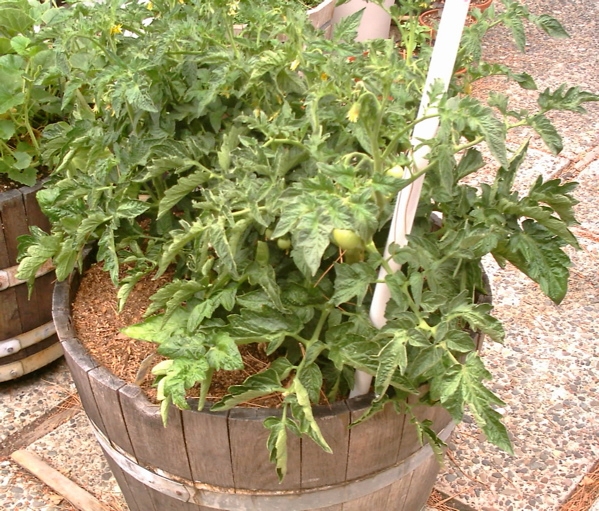Watermelons and Worms in Wine Barrels
Advice from the Help Desk of the
UC Master Gardener Program of Contra Costa County
Thank you for contacting the Help Desk of the UC Master Gardener Program of Contra Costa County. Your recent email had three related questions:
1. Growing watermelons and tomatoes in large containers…what is the best soil composition for successful growth?
2. What type of soil is best for your tomatoes that will be grown in wine barrels in 8 hours of hot sun?
3. Your compost material has lots of worms in it. The compost will be mixed into a wine barrel in the hot sun. How can you keep the worms alive and well in wine barrels planters in full sun?

Here are some additional thoughts about each approach as well as some notes on the benefits and disadvantages of each approach.
Soil, sand, compost and coconut coir. If you use this approach, it would be best to use a loamy garden soil. Silty loam would be the best. Sandy loam could be used, but in that case you should use less sand in the mixture. Clay soils are generally avoided for watermelon culture because they drain poorly, but they can be productive if irrigated with care to prevent prolonged saturation of the root zone (a condition that favors the development of root rot pathogens) and to allow good drainage between irrigations. Adding plenty of organic matter (e.g., compost or coconut coir) would make both the clay and sandy soils more productive.
If you use garden soil, keep in mind that it can contain insects, weed seeds and disease organisms. For this reason, it would be best to heat the soil in an oven for 1 hour at 210°F to kill any bacteria, fungi, insects, or weed seeds before the soil is combined with the compost and sand.
This soil mixture will be heavier than the commercial potting mixture. Added weight is sometimes a disadvantage for containers. However, since the containers may become a bit top heavy if you have a good crop of large watermelons or tomatoes growing upward on a support structure, the added weight could be an advantage. If you want the planter to be lighter, you could replace the sand in the mixture with either perlite or vermiculite. Those amendments will aid in drainage just as the sand does but would produce a mixture that weighs less than one that includes sand.

Commercial Soil Mixture Combined With Compost And Coconut Coir. Usually a commercial soil mixture does not include any actual soil, but they can still provide a very good growing medium. If you use an available commercial soiless mixture, it would probably not be necessary to add either compost or coconut coir. This commercial mixture's ingredients already include compost, and the peat moss would function in much the same way as coconut coir to improve water retention. Adding compost and coconut coir wouldn't detract but would add to the cost.
One disadvantage of the mixture is that it uses peat moss which is less sustainable than the coconut coir alternative. Peat comes from very slow-growing, slow rotting plants and it typically takes 1,000 years for a bog to add 1 yard to its depth. Coconut coir is a byproduct of the coconut industry and is more easily renewed than peat.
If you want to make your own potting mixture that does not include garden soil or peat moss, you can use a combination of one-third each of compost, vermiculite or perlite and coconut coir. Measure the volume of the coconut coir only after it has been soaked in water since its volume will increase significantly once it absorbs the water. I've have been regularly growing vegetables in containers for many years and always use this potting mixture. It would work well for both the tomatoes and the watermelons.
For additional information on growing watermelons, I suggest you look over the information found at:http://anrcatalog.ucanr.edu/pdf/7213.pdf . For information about growing tomatoes in containers, see http://ccmg.ucanr.edu/files/229047.pdf.
Compost Worms In Containers. In our research, there are varying opinions about the viability of worms in containers. Considering that you mentioned having worms in your containers that will be in the hot sun for 8 hours per day, the worms would not survive in this environment. They prefer moist, cool soil which might be hard to manage in your situation. However, experimentation is always a great learning experience (although maybe not for the worms). For example, you could consider using some shade protection on very hot days. Possibly you could set it up in a way that shades the container but not the plants. Also, be sure that the soil mixture has plenty of peat and/or coconut coir to help retain water.
Thank you for contacting the Help Desk. Feel free to check back with us if you have additional questions.
Help Desk of the UC Master Gardeners Program of Contra Costa County (tkl)
Note: The UC Master Gardeners Program of Contra Costa's Help Desk is available year-round to answer your gardening questions. Except for a few holidays, we're open every week, Monday through Thursday for walk-ins from 9:00 am to Noon at 75 Santa Barbara Road, 2d Floor, Pleasant Hill, CA 94523. We can also be reached via telephone: (925) 646-6586, email: ccmg@ucanr.edu, or on the web at http://ccmg.ucanr.edu/Ask_Us/ MGCC Blogs can be found at http://ccmg.ucanr.edu/HortCoCo/ You can also subscribe to the Blog (//ucanr.edu/blogs/CCMGBlog/).